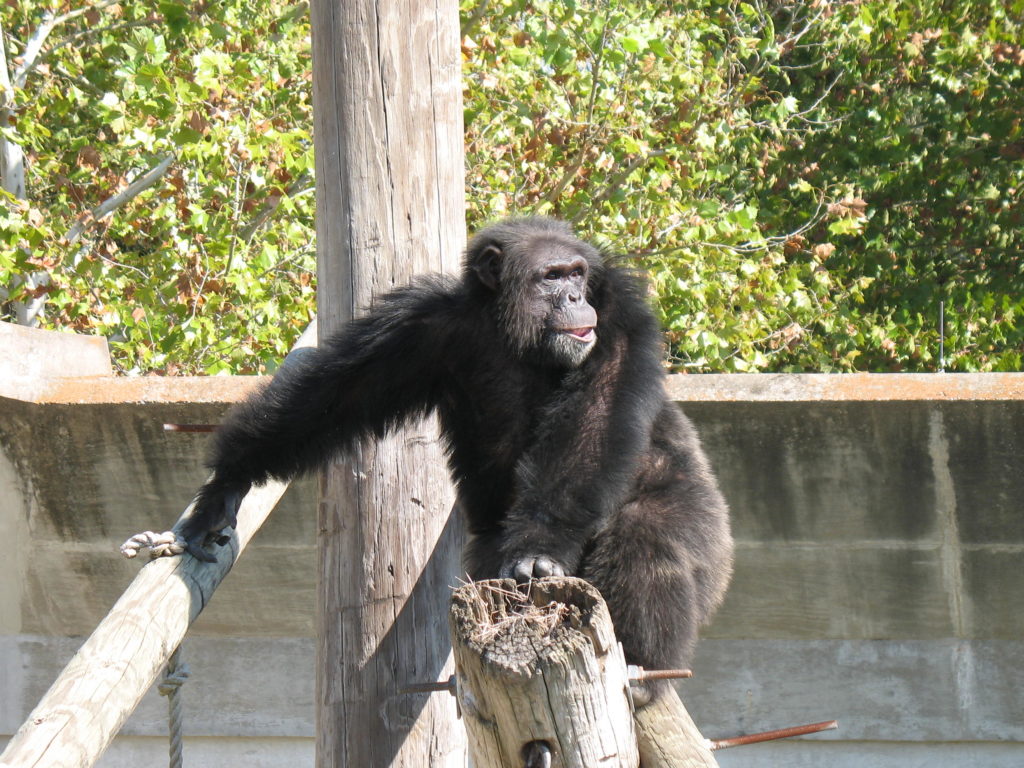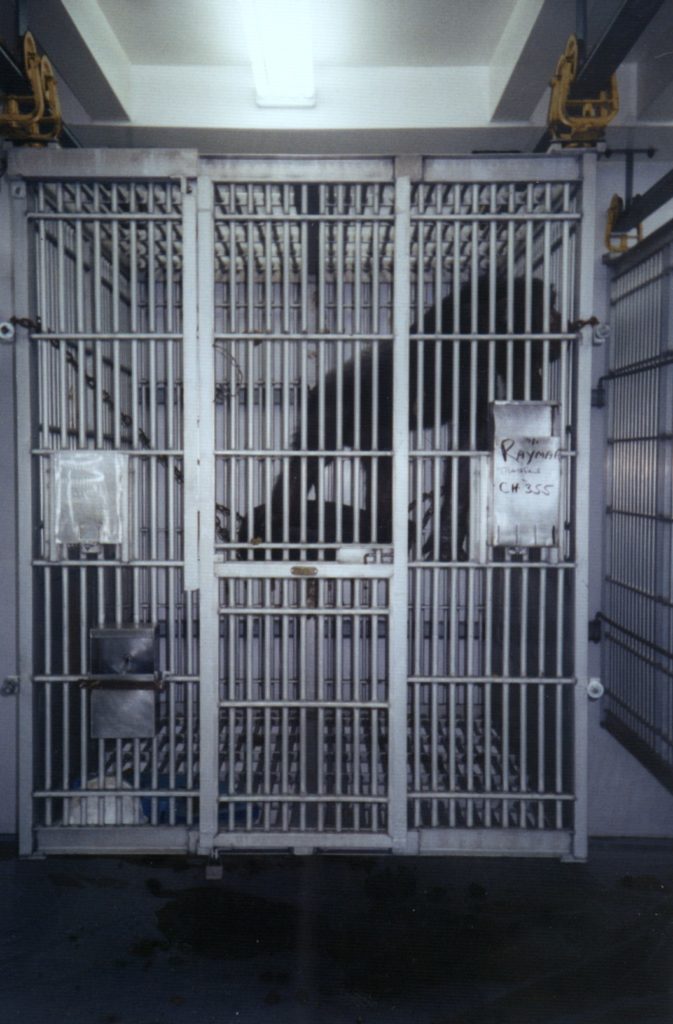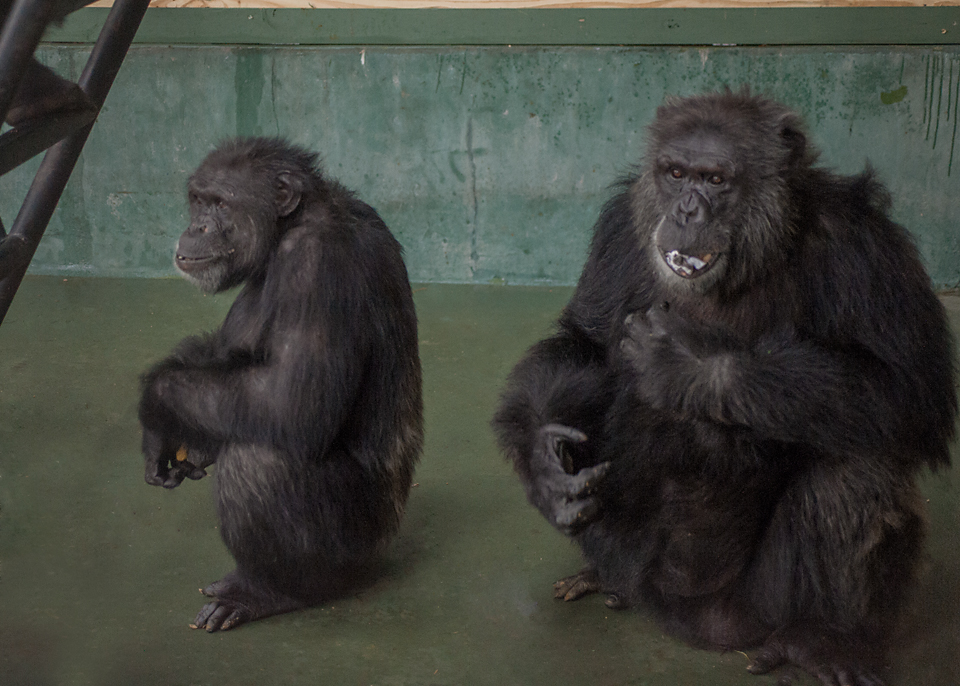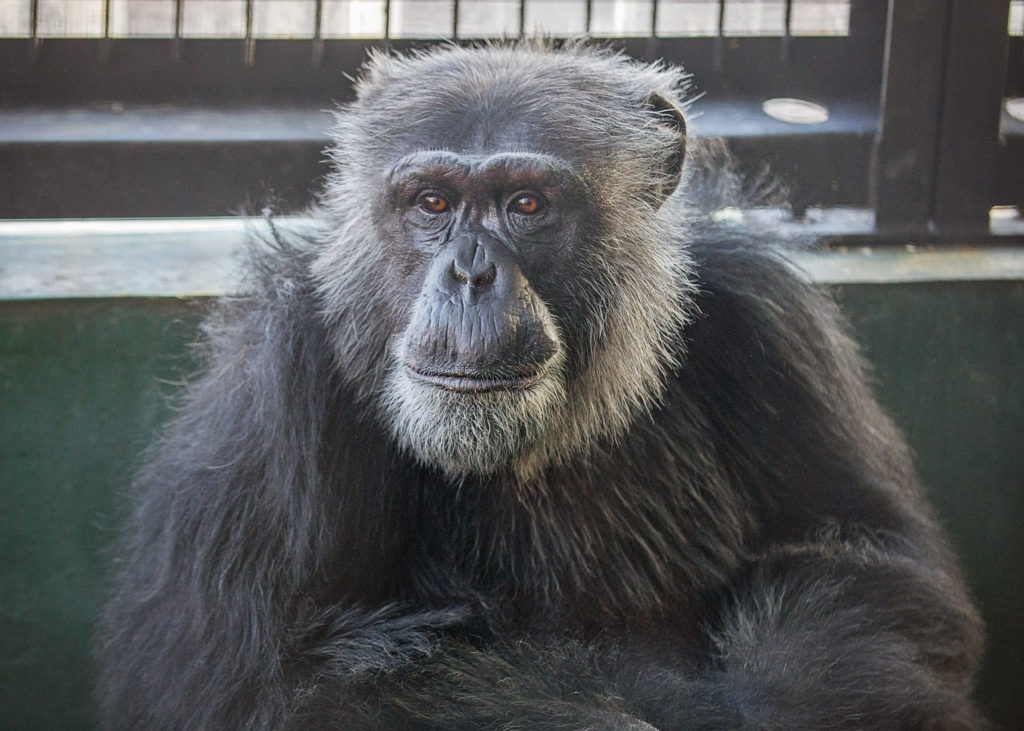
One Chimp’s Journey to Sanctuary – part three

#KareemStrong
If you missed part one, start here
If you missed part two, start here
As we ended the second segment of our three-part series on former research chimpanzee Kareem, he was tranquilized and on his way from Laboratory for Experimental Medicine and Surgery in Primates (LEMSIP) in New York to the notorious Coulston Foundation in Alamogordo, New Mexico.

We have no copies of records from either of these labs to know what exactly was done to him, but we know that he was kept in a tiny cage and regularly anesthetized, exposed to different biological agents, and subjected to surgical biopsies.
Lisa Jones-Engel, Kareem’s first nursery caregiver, moved to Albuquerque in 1994. Knowing that Kareem was nearby, sought permission to visit. She met Coulston’s founder, Dr. Fred Coulston, at the entrance to the lab.
Meeting “the Devil himself”
“There is bad in this world and when you come face to face with it, well that just rocks you on your heels.” This is how Lisa describes meeting Coulston, who she calls “the Devil himself.” Lisa’s feelings were confirmed before the Coulston Foundation closed. The facility was cited with literally hundreds of violations of the Animal Welfare Act and other animal protection laws and federal regulations. There were also endless stories of abuse at that lab. In the end, the federal government seized nearly 300 of the 550 chimpanzees at Coulston because of the tragic situation there.
Coulston escorted Lisa down a long row of cages to the small cage where Kareem lived. “It was a typical chimpanzee research compound. Hard surfaces, rows of cages, and very loud,” Lisa remembers. “Seeing him, I was struck at how much he was still him. I’ve seen lots of broken chimps and monkeys and Kareem was not broken.”
Remarkably, because of the special soul that he is, Kareem was somehow able to survive, despite the horrible conditions and unforgivable neglect to which he was subjected at Coulston Foundation. But his journey in research was not over.
A new lab and a new caregiver
At some point before the Coulston Foundation closed, Kareem was moved to the University of Texas MD Anderson Cancer Center. There he would meet another caregiver, Heather Webb. Like Lisa and Nancy, Heather contacted us when she learned Kareem had made it to Project Chimps, clearly excited to know Kareem was finally in sanctuary.
Heather wrote, “I first met Kareem in 2003, when I started volunteering for the behavioral department at MD Anderson in Bastrop, TX. I fell completely in love with all the chimps I met, but I usually refer to Kareem as the chimpanzee love of my life.”
The feeling was not mutual, at first. Kareem tested Heather as if he was trying to incite her, to see what would happen if he misbehaved. After six months of spraying her with water and no recourse from Heather, he stopped. And they eventually became friends.

Kareem could see the trees
Things were better for Kareem at MD Anderson than his previous research facilities. At MD Anderson, he lived with a bachelor group of males and had outdoor access with structures to climb. Kareem could see the trees, he just couldn’t touch them. Not until he got to Project Chimps in 2018.
Kareem’s caring and intuitive nature continued to show at MD Anderson, even after all he had been through. Heather described one moment for her that really makes Kareem shine in her memory. She had lost someone dear to her and had spent the morning crying before she went to work. When she fed Kareem his morning banana, Kareem at first took the banana. But he obviously recognized, because of his special personality, that Heather was not in her usual mood and was very sad. Kareem then did something that proved his caring nature, despite all that had been done to him by other humans. Sensing her sadness, Kareem insisted that she take the banana back. “It’s as if he were saying, you need this more than I do,” Heather said.
Kareem has kept his giving, and forgiving, character to this day. When I told Heather that Kareem was still trying to share his bananas with his new caregivers at Project Chimps, she laughed and said, “That’s my Kareem.”
In 2010, Kareem left MD Anderson and moved to the New Iberia Research Center in Louisiana. He would stay there for eight years until a chilly day in November, 2018, when he drew the lucky straw and moved to Project Chimps.
Kareem’s current caregivers include our resident photographer, Crystal Alba, and Jill Mullen. Crystal and Jill have stories to share every day about the males in this group, which includes Kareem, Alex, Ronald, Collin, and Jermaine. But Kareem is special.
Kareem becomes a gentle leader
He likes to share. In fact, he seems obsessed with sharing. He will deprive himself of treats and snacks if the caregivers refuse to accept his offer to share. Crystal shares a story about Kareem in which he took a piece of a banana, a favorite treat amongst all the chimpanzees, and held it to the mesh that separates chimps from humans at Project Chimps. He hung on to the piece of banana and focused on Crystal until she made eye contact. She tried to indicate to Kareem that he could have his whole banana. But Kareem was insistent and would not eat his share until Crystal not only accepted the piece he was offering, but pretended to eat it too.
Satisfied, Kareem finished his own snack.
Crystal and Jill report that Kareem is an excellent and benevolent leader. His peaceful demeanor keeps his group quiet and calm. And that’s a good thing, because Kareem seems to love the choices, and the peaceful reflection, available to him at Project Chimps. During the excitement of meal times, he usually goes and sits outside, letting his group mates eat first, knowing his caregivers will serve his food outside eventually. Or if there’s a dispute within the group, Kareem will go outside, seeming to seek a place of calm, and then come back when things are quiet again. He leads by example of his personality, not by force or anger.

Kareem is a protector
Kareem rarely reprimands his group mates but if they really try his patience he’ll display at them a bit to let them know he is the boss. He definitely knows his size but does not use it to intimidate. Kareem displays at other chimps from other groups if he is out in the habitat – letting them know he is the protector of his group. But then he quickly reassures his group mates that it’s not directed at them.
This trait of tending to others appears to be something Kareem was born with. It is both his grace and his curse. It is the very reason he was chosen to go to the misery of the Coulston Foundation and stay in research when his fellow chimps were sent to other facilities. But all of that is behind him now.
Kareem celebrates a milestone birthday
Unlike some of the other chimps that have moved here, Kareem has lived with females before and he has been outside with an unobstructed view. He has been loved and respected. But he has also been used in research, shuttled around the country to a multitude of labs, separated from his friends, thrown into new groups and new experiments. In fact, he spent nearly half of his life in a hell on earth for chimpanzees at the Coulston Foundation. He was deemed to be a chimp who had inner strength in part because of his fundamental core of emotional strength and adaptability, and also because Kareem understood the power of making connections with other chimps and his caregivers.
But now he has found his lifetime family. He will never again have to leave his friends, or be subjected to biopsies, or be used as an “experiment.” He will roam the woods and buildings of Project Chimps with people and chimpanzees who love him for who he is, and the chimpanzee he will continue to grow into being.
Kareem’s former caregivers Lisa, Nancy, and Heather all have an open invitation to visit Project Chimps and to visit Kareem. They wonder if he will remember them and we suspect he will. Will he still offer them gifts? Chimpanzees can hold grudges but Kareem doesn’t seem to have any enemies, he seems to forgive, to love, to embrace. Kareem is strong. He is one of those chimps that grabs your heart and squeezes.
Happy Birthday Kareem
Kareem celebrates his 30th birthday today, Dec 30th. He has lived in four labs in four states and made one final, last move to his fifth state and his first sanctuary. Now, finally, he is home. Forever.
Chimpanzees can live more than 50 years in captivity, so it’s possible we will have the honor of providing care and enrichment for Kareem for another twenty years. We sure hope so, and we will do everything we can to make that happen. If you’d like to help us, please consider Kareem and the chimps in your year-end giving.
Please join us in wishing Kareem a very special and very happy 30th birthday!

